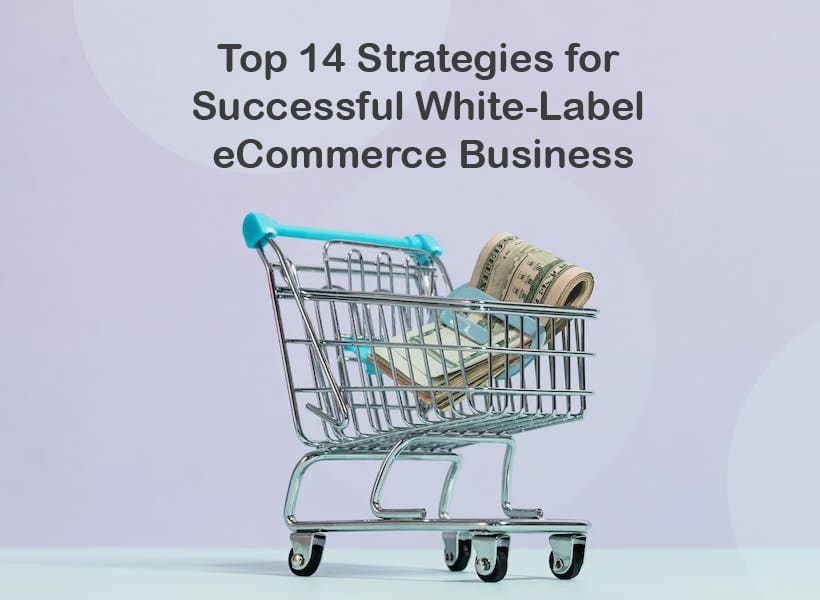Top 14 Strategies for Successful White-Label eCommerce Business

White-label ecommerce services enable companies to sell products online under your brand, not the providers.
White-label services allow companies to have more control over the customer experience while taking advantage of another firm’s technology and operational infrastructure.
White-label ecommerce comes with its challenges compared to more traditional approaches. Through this, businesses can ensure the future success of their white-label initiatives by holding to certain basic strategic principles from the beginning.
Thinking about establishing a white-label business? White-label ecommerce business requires insights for implementation. Pick up the top 14 strategies from this blog.
Strategy 1: Know Your Core Competencies
An honest assessment of internal capabilities is the first step toward being a thriving white-label merchant. White-label sites are even more dependent than other forms of ecommerce on effectively playing to the strengths of both wholesalers and retailers in a strategic alliance.
Looking from the wholesaler’s side, its core competencies are probably limited to technology and fulfillment logistics; inventory management, and backend operations. As a potential retailer, your organization has intimate knowledge of the target audience, marketing know-how, and branding ability. It also possesses high front-end specialization in the area of merchandising itself. These complementary skill sets need to be clarified early on so as not to create tension later. Additionally, aligning retail operations strategies with a pre inspection checklist can optimize the synergy between both entities for a seamless customer experience and efficient supply chain management.
Strategy 2: Develop a Future-Proof Business Plan
Foresight creates a blueprint for white labeling success. The strategies most likely to succeed, therefore, are the ones that don’t just pursue short-term revenue targets but take into account long-term market fluctuations. When writing a business plan, you should always consider the challenges your brand is likely to face three or five years into its future.
Design contingency plans to deal with economic fluctuations, changes in consumer demand, supply chain problems, and platform lifecycle limitations. Tools like a supply and demand graph maker can help visualize potential market shifts and prepare for various economic scenarios. Now considering future scenarios makes it easier to change direction when circumstances dictate.
Creating a future-proof business plan using traditional templates can be quite overwhelming and tiring, using a business plan builder would be the right approach. For those unsure of where to start, using a free sample business plan can provide valuable insights and a solid foundation for crafting your own strategy. These templates simplify the process and ensure that all critical factors are addressed.
Strategy 3: Get Buy-In Across Your Organization
One easily made mistake is to think that white-label projects belong in the province of a single internal department. Siloed projects don’t exploit the overall abilities of an organization. Seeking early comments from across departments increases internal cooperation while revealing weaknesses in the deployment strategy.
Not only does keeping leadership, technology teams, sales staff, and creative departments involved ensure efforts don’t tread water. Maintaining the engagement of end-users also smoothes out kinks preventing adoption. Involving input from all levels of the hierarchical structure translates into better, more coherent strategies with a greater rate of implementation. Fractional COO consulting can facilitate this process by objectively mediating cross-departmental communication and translating strategic objectives into actionable operational plans.
Strategy 4: Understand Your Audience Intimately
Retailers are the white-label storefront’s public face, and it is their responsibility to reach out to customers. You have to jump into the target demographics ‘behavior, taste racism, disappointment, and expectations. From data analytics to real-world research: Robust audience insights involve both.
Online surveys, social listening, web analytics, or chatbot conversations–combined with ethnographic research-all provide crucial details to help in calibrating a properly targeted brand message. Local white labeling depends on the continued profiling of ever-changing consumer needs.
Strategy 5: Research Competitor Landscapes
In actuality, monitoring competitors’ white-label offerings helps prevent flooding of saturated markets. It also points to holes where your company can fill consumer needs that have gone unmet through personalized offerings. Rated competitors along axes such as product line, pricing strategy, site features, marketing copy and branding.
Seek to identify shortcomings in the customer experience that your own white-label operation can surpass. Adding competitive intelligence prevents redundant storefronts and provides direction for innovation.
Strategy 6: Pick the Right Platform Partner
But behind every stable white label front end is a powerful, scalable technology architecture. Choosing the wrong platform threatens market potential and exacerbates security risks. Vetting providers means looking beyond a list of features. Which ones are flexible? Transparent? Have compliance frameworks, maintenance policies, and disaster recovery provisions in place to support your IT activities during turbulent times ahead?
Focus on partners with a commitment to continuous improvements of the platform to maintain market lead. Ask for detailed documentation on all aspects of a provider’s infrastructure, and in particular request information about security specifications along with historical uptime. What’s more, watch out for vendors with dubious service policies or other hidden fees. A good platform gives merchants more control, not less.
Strategy 7: Optimize Omnichannel Experiences
In white-label plans, bearing modern buyer habits in mind seamless omnichannel journeys need to be at the center of it all. Work out precisely how customers will encounter your branded products across the different mediums and platforms, such as PC or mobile device interfaces; shops and call centers; and voice assistants.
Look for possible areas of conflict between channels, and then design failsafe hand-offs that preserve context. Mobile and desktop, for example–past browsing history should persist across both. Connected paths encourage conversion, while disrupted experiences result in abandonment.
Strategy 8: Allocate Dedicated Resources to Content Marketing & SEO
In a crowded market, white-label stores depend on powerful storytelling and messaging to stand out. For use in long-term content campaigns, develop resources that bring your products’ purpose-driven narratives to the forefront.
This is why search engine optimization still remains important for driving organic traffic to new sites without reputation or external links. In launch plans for these areas, allocate creative and analytical talent in-house or contracted to drive the growth of rankings as well as enhance visitor experiences. But beware of underestimating timelines before you start to see tangible gains from SEO and conversions.
Strategy 9: Research Local Compliance Factors & Localization Requirements
The changing location-based legal compliance needs mean migration must be contemplated for white-label operations to expand smoothly around the world. Follow these localization steps carefully before chasing across borders:
First, study related regulations on data privacy and retention; secondly, understand the tax laws in various countries that affect transactions everywhere. Also, be familiar with different kinds of translation services (including language) as well as currencies used by banks so you know how to prepare for your payment premature death abroad! Prepare nuanced timelines and budgets considering customized configuration to prevent financial penalties or the forced inaccessibility caused by compliance gaps, based on target regions.
Strategy 10: Construct Clear Exit Strategies in Contracts
Even with the best efforts at the start, as business needs change some white label partnerships have run their course. To avoid scrambling later to change course in asset portfolio management or unwind operations, you can specify disengagement procedures directly within partner contracts. Use legal agreement templates to ensure that all necessary terms and conditions are clearly outlined, providing a solid framework for disengagement if needed.
Isolate potential sources for transferring ownership of customer data, as well as handing over revenues and brand image custody to make breaking things off clean even if you are faced with customer churn in the future.
Strategy 11: Commit to Continuous Improvement Cycles from Day One
The launch is just the beginning: refined white-label experiences race ahead of competitors. Monitor customer interactions and conduct field studies through multimedia surveys. As quantified standards to track performance, set quarterly success benchmarks highly correlated with KPIs on conversion rates and retention & referrals.
Funnel valuable lessons from routine evaluations into platform revisions, creative renewals, and process revamps to make what’s offered fit the needs. However, build agile-focused review cycles that apply fixes promptly as well on steady feedback.
Strategy 12: Strengthen Supplier Relationships
White-label models rely significantly on supplier reliability to ensure consistent inventory and fulfillment. When vetting suppliers, prioritize criteria such as quality controls, logistics capacities, financial stability, and a smooth customs declaration process to maintain a seamless supply chain operation.
Structure contracts to encourage clear communication and a sensible amount of notice for changes that affect the joint venture. Proactively implement supplier relationship management strategies through forecasting, incentive structures, and loyalty perks to foster win-win commitments.
Strategy 13: Explore Expanded Monetization Verticals
Established audiences provide only one revenue stream for core purchases. Consider opening up other monetization areas, such as subscriptions, use fees and dynamic pricing, service levels or bundled products. Using A/B testing on pricing factors and product packs, zero in on the packages with the highest value. Diversified income verticals also help insulate against seasonal swings in sales.
Strategy 14: Maintain Laser Focus on Security
Profoundly depends on the perceived security and integrity of data. Work jointly with your white-label provider in allocating resources specifically for maintaining adequate, stable cybersecurity foundations and incident response plans as well as regular audits.
Take best practices in the encryption of payment data, access controls, and vulnerability tests not as luxurious add-ons but rather necessities. Addressing emerging attack vectors early anticipates sensitive information threats that could irreparably damage brand reputation if compromised.
Only pragmatic preparation makes white labeling successful. Retailers must steer clear of recurrent difficulties in implementation, based on research. Understanding the intricacies of this particular e-commerce model can increase your returns while giving you a head start in the future. If thoughtfully planned around core competencies, retailers can become the outward face of a win-win white-label group.

